How To Shift Shimano Dual Control!
Shifting (also called changing gears) is the secret to riding comfortably and efficiently whether you're climbing and descending, sailing along fireroads with
| ||
| Note that Shimano Dual Control shifters come with removable thumb levers. It's your choice whether to leave these attached and shift with them or remove them and shift exclusively with the main levers (which double as the brake levers). It's our experience that the latter becomes easy and natural with just a little practice. Another detail about Dual Control shifters is that they're recommended for use with Shimano's Rapid Rise rear derailleur (also called Low Normal). This derailleur differs from all other standard derailleurs in that the main spring pushes the derailleur the opposite way (moving the chain onto the larger cogs instead of the smaller ones). The instructions here show how to shift with and without the removable thumb levers, and assume that you're using a Rapid Rise rear derailleur. If you're not sure what's on your bicycle, just ask and we'll let you know. Shifting the right lever (see the illustrations below) controls the rear derailleur and moves the chain onto the different cogs in the rear. Notice that there are 2 levers, the main lever, which is also the brake lever, and the lever behind it, the inset lever. You move these levers separately. The main lever can be pressed down and lifted or pulled up (place your extended fingers beneath it and lift, or grab it with your fingertips and pull). The inset lever is pushed with your thumb. | ||
| When you're just riding along, your hand rests on the handlebar grip with the shift levers within easy reach, right at your fingertips. | 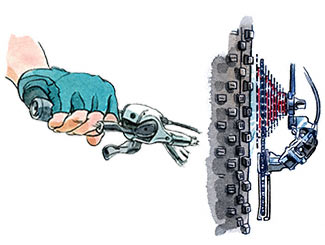 | |
| When you feel like it's too hard to pedal and want to shift into an easier gear, you can: 1. Extend your fingers so they're beneath the main lever and lift up. Or, 2: Press the thumb lever. Or, 3: Grip the main lever with your fingertips and pull up on it. Any of these actions causes the lever to click with each lift/pull/push and this moves the rear derailleur, which in turn shifts the chain onto the next larger rear cog making it easier to pedal. You can click the lever again to shift into an easier gear, and so on. | 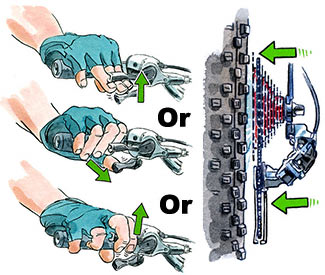 | |
| When you feel like it's too easy to pedal and you'd like a harder gear, you push down on the main lever. It clicks with each push and this moves the rear derailleur, which in turn shifts the chain onto the next smaller rear cog making it harder to pedal. You can repeat as needed. | 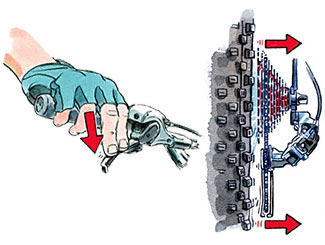 | |
| Shifting the left lever (see the illustrations below) controls the front derailleur and moves the chain onto the different chainrings. Notice that there are 2 levers, the main lever and the lever behind it, the inset lever. You move these levers separately. The main lever can be pressed down and lifted, or pulled up (place your extended fingers beneath it and lift, or grab it with your fingertips and pull). The inset lever is pushed with your thumb. | ||
| The left lever operates like the right lever, with 2 levers, a main one and an inset one. Because the chainrings vary so much in size, the main lever must be pushed a little further to complete a shift. Like the right lever both levers are within easy reach at all times. | 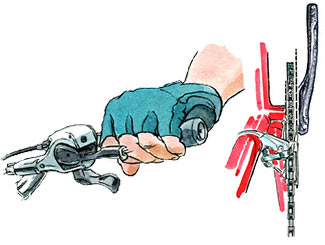 | |
| When you need to make it a lot easier to pedal (as you will when you come to uphills), you can: 1. Extend your fingers beneath the main lever and lift it up. Or, 2. Push the inset lever with your thumb. Or, 3. Grip the main lever with your fingertips and pull up. These actions shift the front derailleur inward moving the chain onto a smaller chainring with each click of the lever, which makes it a lot easier to pedal the bicycle. | 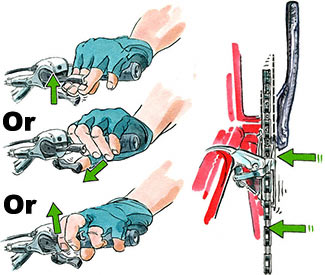 | |
| When you need to make it a lot harder to pedal (as you will when you crest a hill and start going a lot faster down the other side), you push down on the main lever with your fingers, which moves the front derailleur outward shifting the chain onto a larger chainring making the bike a good bit harder to pedal. | 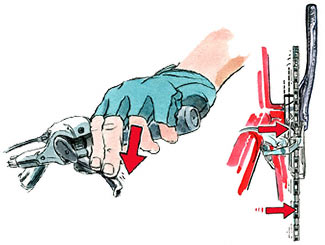 | |
| That's all there is to it! Now, with a little practice you'll be shifting up a storm and having more fun than ever. Remember, if you have any questions about shifting or anything else cycling, just drop by. We're always happy to help! And, please keep in mind, that if your derailleurs are out of adjustment and your bicycle isn't shifting properly any more we're happy to help you with the problem and get your bike shifting like a champ again. Just let us know. Thanks! | ||
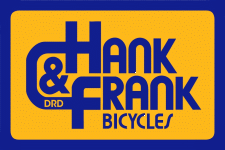
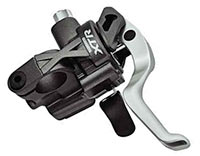 glorious tailwinds, pedaling for pleasure or going for glory. And today bicycles are easier, more efficient and more fun to shift than ever thanks to modern shifting systems that let you change gears almost as fast as the thought crosses your mind. And you never even need to move your hands from the handlebars!
glorious tailwinds, pedaling for pleasure or going for glory. And today bicycles are easier, more efficient and more fun to shift than ever thanks to modern shifting systems that let you change gears almost as fast as the thought crosses your mind. And you never even need to move your hands from the handlebars!